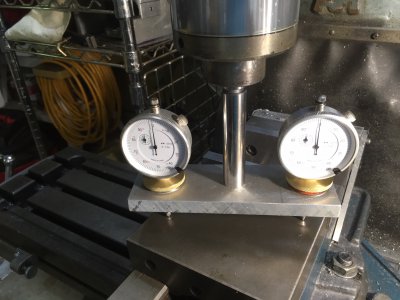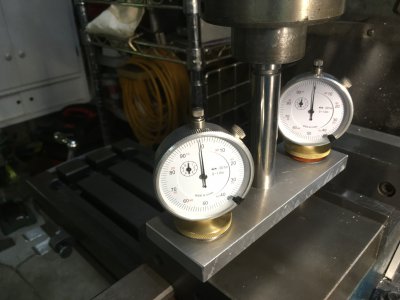- Joined
- Jul 29, 2014
- Messages
- 2,728
You know the dual dial indicators on a bar that you use to tram a mill, compared to sweeping a single indicator? It got a little tedious with a single indicator, lots of move the head, check, no, wrong way, try again, rotate indicator, what was that last reading? Was it plus .002 or minus .002? So I built a dual indicator bar, where the stem of the indicators were held at the right height with a screw through the side of the bar. That was a good improvement, but it seemed like half the time the indicators faced the wrong way. A little annoying.
so I had a couple of 6202 bearings lying around. Not in this order of operations, but to explain, I pressed the bearings into the bar, pressed a brass insert turned to the ID of the bearing into each bearing, and tapped a 1/2-13 thread through it. I pressed another brass piece knurled like a thumbwheel onto the bushing. Then, I had some matching 1/2-13 all-thread, cut a short piece and bored through it to take a snug fit on the indicator stems, and super glued the all-thread to the stems. Then thread the indicators through the threaded brass inserts.
So you see the idea...it you just rotate the brass insert (and thumbwheel) the indicator rotates with the insert for better viewing but does not move at all vertically. However if you hold the brass insert and rotate the indicator relative to the insert, you can screw the indicator up or down precisely, much easier than with a screw through the side. This makes it very easy to zero the indicator. Set one side to zero with the quill or knee, swing the bar 180 and holding the indicator facing you, thumbwheel it to zero. You’re zeroed. Rotate the indicators as needed for visibility. Tram as normal, but always being able to see both indicators easily and simultaneously is very convenient.
Now, I actually like tramming the mill. Really.
Yes, you can see that the top of my vise is .001 out front to back. The table is level, the vise body and fixed jaw are just right, it’s a not important part of the vise that’s out .001 over 5”. Shoulda got a Kurt I suppose.
Winegrower


so I had a couple of 6202 bearings lying around. Not in this order of operations, but to explain, I pressed the bearings into the bar, pressed a brass insert turned to the ID of the bearing into each bearing, and tapped a 1/2-13 thread through it. I pressed another brass piece knurled like a thumbwheel onto the bushing. Then, I had some matching 1/2-13 all-thread, cut a short piece and bored through it to take a snug fit on the indicator stems, and super glued the all-thread to the stems. Then thread the indicators through the threaded brass inserts.
So you see the idea...it you just rotate the brass insert (and thumbwheel) the indicator rotates with the insert for better viewing but does not move at all vertically. However if you hold the brass insert and rotate the indicator relative to the insert, you can screw the indicator up or down precisely, much easier than with a screw through the side. This makes it very easy to zero the indicator. Set one side to zero with the quill or knee, swing the bar 180 and holding the indicator facing you, thumbwheel it to zero. You’re zeroed. Rotate the indicators as needed for visibility. Tram as normal, but always being able to see both indicators easily and simultaneously is very convenient.
Now, I actually like tramming the mill. Really.
Yes, you can see that the top of my vise is .001 out front to back. The table is level, the vise body and fixed jaw are just right, it’s a not important part of the vise that’s out .001 over 5”. Shoulda got a Kurt I suppose.
Winegrower



